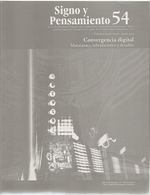Abstract
Book review: Zielinski, S. (2006). Deep Time of the Media: Toward an Archaeology of Hearing and Seeing by Technical Means. Trad. del alemán: Gloria Custance. Cambridge- Londres: MIT Press. 375 páginas. ISBN: 0-262-24049.
There was a "deep time", in which the media had not been invented, let alone convergence. After electricity came and the human being gave to use it to communicate with their peers. At that time unexplored and gray belong the characters of this book, originally published in German and, at a good time, published in English by MIT.
From paleontology the author took a concept that helped him to orient himself through the prehistory of the media: civilization has not followed a divine plan; Under thick layers of granite there are unknown treasures that are worth discovering. The history of the media is not, then, the product of the advance from some primitive devices to more complex ones. The media are, rather, spaces, of attempts to connect what is separate.
This journal is registered under a Creative Commons Attribution 4.0 International Public License. Thus, this work may be reproduced, distributed, and publicly shared in digital format, as long as the names of the authors and Pontificia Universidad Javeriana are acknowledged. Others are allowed to quote, adapt, transform, auto-archive, republish, and create based on this material, for any purpose (even commercial ones), provided the authorship is duly acknowledged, a link to the original work is provided, and it is specified if changes have been made. Pontificia Universidad Javeriana does not hold the rights of published works and the authors are solely responsible for the contents of their works; they keep the moral, intellectual, privacy, and publicity rights.
Approving the intervention of the work (review, copy-editing, translation, layout) and the following outreach, are granted through an use license and not through an assignment of rights. This means the journal and Pontificia Universidad Javeriana cannot be held responsible for any ethical malpractice by the authors. As a consequence of the protection granted by the use license, the journal is not required to publish recantations or modify information already published, unless the errata stems from the editorial management process. Publishing contents in this journal does not generate royalties for contributors.


